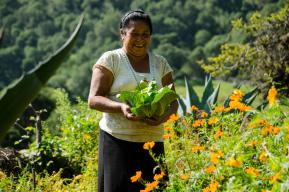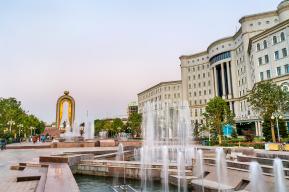Article
LiBeirut: the iconic Sursock Museum comes back to life

Perched on a ladder, brush in hand, Ahmad is working his magic to bring the arcades of the Salon Arabe back to their former glory, on the first floor of the Sursock museum. Such meticulous craftsmanship is commensurate with this jewel that sits on a hill in Ashrafieh in the Lebanese capital and celebrates Venetian and Ottoman architecture. Over the years, the halls of this manor, which became a museum in 1961, have welcomed artists from the Middle East and from all around the world. The manor itself was President Camille Chamoun’s pride and joy and his go-to for meetings with senior officials. Renowned Lebanese talents, the likes of Chafic Abboud, Paul Guiragossian, Saloua Raouda Choucair or even Aref Rayess, have left their mark in Sursock. “The 60s were the dawn of Beirut’s transformation into a cultural hub; they marked the beginning of a movement that would influence the four corners of the Arab world,” recalls César Nammour, famous art critic who disappeared in 2021, “Artists were quite enthusiastic. The Museum selection committee received 300 applications on a regular basis, only to select 80. Being selected by Sursock was a big achievement. Evenings at the museum were nothing short of memorable.”

However, on this spring afternoon in the city of Beirut, silence reigns in the halls of this cultural institution that teemed with life three years ago. The Museum, which was renovated and expanded between 2007 and 2015, was severely damaged by the deadly blasts of the Port of Beirut. The institution, that never suspended its activities during the war, had to close its doors because of the magnitude of the damage. Elsa Hokayem, Sursock Museum Associate Director at the time, remembers the explosion as if it happened yesterday. “We were in our offices when the explosion happened. It felt like the entire Museum collapsed,” she described, “my colleague and I stayed on the stairs between the offices for a long time, covered in dust. It seemed like the only safe place to be. It was only after 30 minutes that we managed to get out of the building without really understanding what had happened. The destruction was unfathomable. If felt like the apocalypse. Windows were broken, paintings were on the ground, scratched and scraped and ruined. Nothing was left in place. To this day, I have a hard time accepting what happened. This incident left us deeply scarred.”
A reborn community
Despite the destruction, the iconic Sursock Museum, a unique cultural institution in the Middle East, is currently preparing to reopen its doors in May, after emergency interventions were carried out that allowed for a massive rehabilitation project financed by the Italian government, through the Italian Agency for Development Cooperation (AICS). The over €1 million UNESCO project constitutes- as of today- the largest investment by one single donor in the Beirut cultural heritage as an integral part of the UNESCO flagship initiative, LiBeirut. It completed necessary works related to lighting systems for the exhibition galleries, replacement of internal partitions, restoration of fire doors, glass walls and ancillary equipment, as well as the installation of electromechanical systems and solar energy panels to ensure green and sustainable energy consumption. “The Sursock Museum, the first rehabilitation project launched jointly by Italy and UNESCO in the field of cultural heritage after the explosion, represents a key demonstration of our commitment to the recovery of Beirut, says Italian ambassador to Lebanon Nicoletta Bombardiere. We firmly believe that culture and the protection of heritage are more necessary than ever in times of crisis”.
These statements are taken up by the artist and filmmaker Joana Hadjithomas, a regular of the Museum who is delighted with the close completion of the work. " In the heart of Beirut, the Sursock Museum is an essential place where we have always liked to go and which has seen so many exhibitions and Salons d'Automne," she says. It’s that kind of vital place for the cultural community because it creates connections. First between modern and contemporary art but also between past and present. This museum, with its permanent collections and its photographs, ensures continuity in a country that is constantly experiencing ruptures. In Lebanon, artists grow up without knowing those who preceded them and this is where the role of the Sursock museum is essential. Not to forget that it is a place that lives in the present, with many activities offered in one of the few cultural public spaces in Beirut.”
With the imminent reopening of the museum, the permanent collection as well as the famous Fouad Debbas collection will be on display again. The two twin galleries, completely renovated, will also host works of art by three Lebanese artists whose names are on the rise: filmmaker and multimedia artist Ahmad Ghossein, filmmaker, artist and researcher Marwa Arsanios, and architect Sabine Saba. The curator, Marie-Nour Hechaime, is confident that “the re-opening of the Sursock Museum thanks to UNESCO and Italy's support will make a difference within the cultural sector. It gives a platform for artists to exhibit their work but also encounter new projects, meet with the public and attend many events.” “Cultural life has suffered greatly due to the explosions and exodus of artists; we need good working conditions and engaging institutions to ignite recovery,” she said.
At the entrance to the museum, passers-by take a break to admire the white building, its stained glass windows and its atypical staircases. Others roam the esplanade to sit in the shade in the adjoining café. “My friends from abroad had a very pleasant time at the Sursock museum a few years ago, assures Lama, a young Lebanese now living in New York. It is an emblematic place in the touristic life of Beirut and its activity which will soon resume can only be beneficial in these difficult times.” “I really do believe that the return to life of the Sursock museum sends a message of hope, confides Antoine, her partner. To know that people are working tirelessly to rebuild Beirut. Wherever we go around the world, we only hear negative news about Lebanon. But when we visit this place and get a sense of this rehabilitation project, we feel assured and confident that there is a will to live and a path forward.”

LiBeirut is an international flagship initiative launched from Beirut by the Director-General of UNESCO, Audrey Azoulay, on August 27, 2020, in the aftermath of the port explosions, to support the rehabilitation of schools and educational institutions, historic heritage buildings, museums, galleries, and the creative industry, all of which suffered significant damage in the deadly explosions.






















